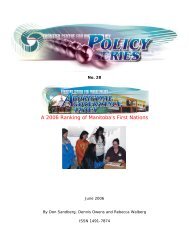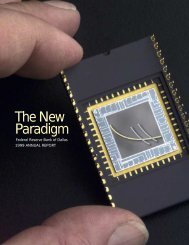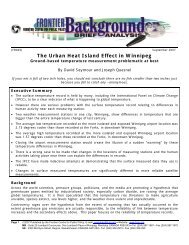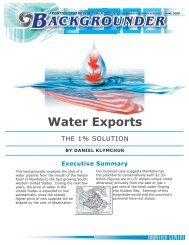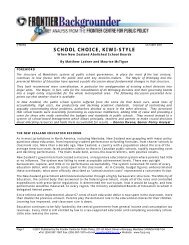The New Paradigm - Federal Reserve Bank of Dallas
Create successful ePaper yourself
Turn your PDF publications into a flip-book with our unique Google optimized e-Paper software.
12<br />
Exhibit 7<br />
A Compendium<br />
<strong>of</strong> Cost Cutting<br />
Telecommuting<br />
<strong>The</strong> ability to work productively at home<br />
has jumped, thanks to the spread <strong>of</strong> personal<br />
computers, e-mail, fax machines, cell<br />
phones and the Internet. Roughly 30 million<br />
adults currently use the Internet at<br />
home for business purposes. <strong>The</strong> proportion<br />
<strong>of</strong> workers with flexible schedules has<br />
risen sharply, from just 15 percent in 1991<br />
(when the World Wide Web was introduced)<br />
to nearly 30 percent today.<br />
Roughly 20 million Americans now telecommute,<br />
working at least one day per<br />
month from home during normal business<br />
hours. Studies show that telecommuting<br />
saves businesses roughly $10,000 annually<br />
for a worker earning $44,000—a<br />
savings in lost work time and employee<br />
retention costs, plus gains in worker productivity.<br />
By freeing us from the 8-to-5<br />
company <strong>of</strong>fice so we can work when and<br />
where we do it best, technology has cut<br />
the cost <strong>of</strong> getting the job done nearly a<br />
quarter.<br />
Laparoscopic Surgery<br />
Approximately 600,000 people in America<br />
had their gallbladders removed last<br />
year, 95 percent <strong>of</strong> them with a new technique<br />
known as laparoscopic cholecystectomy.<br />
<strong>The</strong> procedure uses a smart surgical<br />
tool known as a laparoscope—consisting <strong>of</strong><br />
a digital camera (advanced models containing<br />
three or more chips), fiber-optic<br />
cables and a video monitor—and requires<br />
only three or four 1/3-inch incisions.<br />
Patients can resume normal activities in<br />
just one week, compared with six weeks or<br />
more with yesterday’s highly invasive surgery.<br />
<strong>The</strong> 85 percent reduction in lost work<br />
time isn’t the only savings. <strong>The</strong> procedure<br />
itself costs roughly 10 percent less in hospital<br />
and physician fees. Similar savings<br />
apply to laparoscopic procedures involving<br />
the stomach, appendix, esophagus, abdomen,<br />
colon and other organs.<br />
Precision Farming<br />
With precision farming technology, remote<br />
sensors on harvesters linked to GPS satellites<br />
enable growers to make straighter<br />
rows, reduce swath overlap and crop compaction,<br />
operate in low-visibility conditions<br />
(even at night) and increase field production<br />
with reduced operator time. And<br />
whereas traditional soil testing occurs<br />
every 2 1 /2 acres, new digital mapping s<strong>of</strong>tware<br />
computes crop yields every few feet,<br />
so growers can zero in on specific areas<br />
where yields are down. Soil-testing costs<br />
fall from roughly $50 per sample using old<br />
methods to under $8; yields are up; farmers<br />
can segregate their harvests into, say,<br />
$15-a-bottle and $30-a-bottle grapes; and<br />
trucks can be packed more accurately to<br />
avoid fines for overloading and the inefficiencies<br />
<strong>of</strong> underfilling.<br />
Smart Structures<br />
Monitoring and maintaining the soundness<br />
<strong>of</strong> dams, bridges, buildings and tunnels can<br />
be expensive. According to the <strong>Federal</strong><br />
Highway Administration, 42 percent <strong>of</strong> the<br />
nation’s 578,000 highway bridges are seriously<br />
deteriorated. <strong>The</strong> current way to keep<br />
tabs on the structures’ health is to periodically<br />
drill holes in each one and analyze its<br />
core sample—a labor-intensive proposition.<br />
But by equipping them with a fiber-optic<br />
“nervous system,” data can be collected<br />
continuously on structure strain, temperature,<br />
vibration, magnetic fields, cracks, and<br />
road-salt corrosion and penetration. That’s<br />
exactly what’s been done in Vermont,<br />
where engineers have made the Waterbury<br />
bridge the smartest in the world. What’s<br />
more, embedded in a new dam spanning<br />
Vermont’s Winooski River are four miles <strong>of</strong><br />
fiber-optic cables. Although there to monitor<br />
stresses and strains, the cables provided<br />
an added bonus when spectrum readings<br />
from one turbine showed an unpredicted<br />
vibration, indicating efficiency had dropped<br />
from 92 percent to 81 percent. Out-<strong>of</strong>round<br />
gears were identified and replaced,<br />
saving a significant amount <strong>of</strong> revenue.<br />
Applied to the nation’s entire infrastructure,<br />
the cost efficiencies from smart structures<br />
promise to be enormous.<br />
Lumber Manufacturing<br />
Weyerhaeuser’s state-<strong>of</strong>-the-art Green<br />
Mountain sawmill uses scanners and computers<br />
to optimize the yield and value from<br />
each log. <strong>The</strong> new technology has increased<br />
yields by 30 percent over the past five<br />
years, helping hold down lumber costs.<br />
Lighting<br />
Shed some light on the subject…for less.<br />
Using increasingly sophisticated s<strong>of</strong>tware<br />
plus computer-aided design and testing,<br />
researchers have been able to sharply<br />
reduce lighting costs. Do the math. Illuminating<br />
a porch 10 hours a night, 365 nights<br />
a year with a standard 100-watt, 750–<br />
1,000 hour incandescent bulb costs about<br />
$38 a year (using a rate <strong>of</strong> 10¢ per kilowatt-hour<br />
for electricity and bulb costs <strong>of</strong><br />
30¢ each). Today’s technology-improved,<br />
screw-in 23-watt fluorescent bulb, however,<br />
gives <strong>of</strong>f just as much light, lasts<br />
10,000 hours and consumes only $8.40 in<br />
electricity per year. Spread the $18 bulb<br />
cost over the 2 3 /4 years it will burn and the<br />
total bill comes to just $15 annually. That’s<br />
60 percent less than yesterday’s technology<br />
could deliver. <strong>New</strong>er technologies and<br />
advances in LED lighting provide even<br />
greater cost reductions—energy savings <strong>of</strong><br />
up to 97 percent for bulbs that last<br />
100,000 hours. <strong>The</strong> newest LED bulbs<br />
burn substantially brighter yet can significantly<br />
lower the bill for operating traffic<br />
lights, building exit signs and many other<br />
lamps that must burn continuously.<br />
Plane Design<br />
In making the 777, Boeing pioneered a new<br />
design process that uses a computer program<br />
called CATIA to digitize the entire aircraft.<br />
Eschewing the usual Mylar drawings,<br />
Boeing developed a program that allows<br />
engineers to “fly” through a computerized<br />
prototype <strong>of</strong> the aircraft, iterating the<br />
design in virtual space. <strong>The</strong> result is a big<br />
reduction in cost. Rework time on the<br />
plane’s design was reduced 60 percent to<br />
90 percent over previous models, repair<br />
time has been cut 80 percent and fuel efficiency<br />
is greater, not to mention that the<br />
777’s noise signature is significantly lower.<br />
1999 ANNUAL REPORT <strong>Federal</strong> <strong>Reserve</strong> <strong>Bank</strong> <strong>of</strong> <strong>Dallas</strong>




